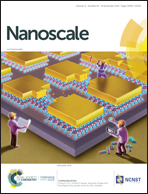Probing surface mediated configurations of nonplanar regioisomeric adsorbates using ultrahigh vacuum tip-enhanced Raman spectroscopy†
Abstract
The ability to directly probe the adsorption configurations of organic regioisomeric molecules, specifically nonplanar isomers, on well-defined substrates holds promise to revolutionize fields dependent on nanoscale processes, such as catalysis, surface science, nanotechnology and modern day electronic applications. Herein, the adsorption configurations and surface sensitive interactions of two nonplanar regioisomer, trans- and cis-tetrakispentafluorophenylporphodilactone (trans- and cis-H2F20TPPDL), molecules on (100) surfaces of Ag, Cu and Au were studied and investigated using high resolution scanning tunneling microscopy (STM), combined with ultrahigh vacuum tip-enhanced Raman spectroscopy (UHV-TERS). Depending on molecule–substrate interactions, similar “phenyl-up” configurations were observed for these molecules on Ag(100) and Au(100), while a “phenyl-flat” configuration was discovered on a Cu(100) surface. With the help of surface selection rules of TERS, we explain the spectral discrepancies recorded on the Ag and Cu substrate. Furthermore, the intermolecular interactions were addressed using STM analysis on these surfaces after the configurations were determined by TERS. This study sheds light on the distinct configurations of regioisomeric porphodilactone systems (at interfaces) for near-infrared (NIR) photosensitizers and molecular electronics in the near future.



 Please wait while we load your content...
Please wait while we load your content...
